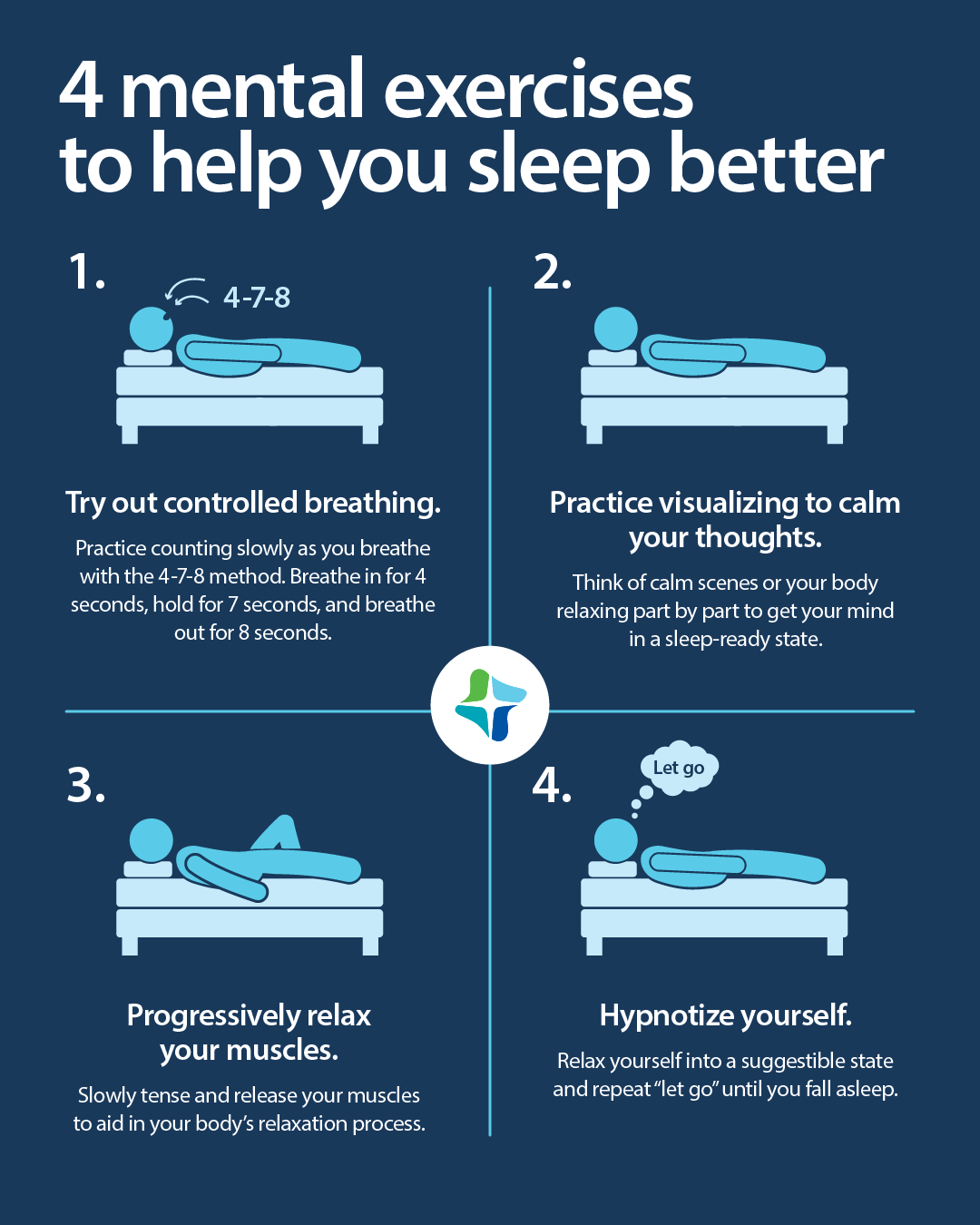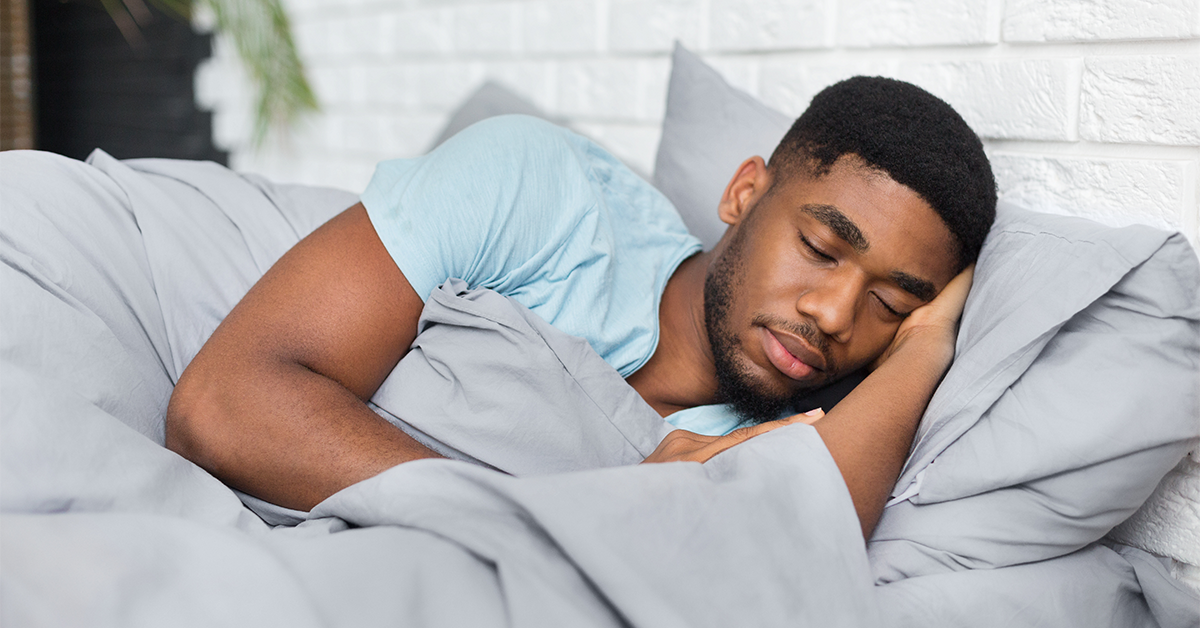70 million people in the U.S. experience chronic sleep problems. Losing out on sleep can cause various health problems, symptoms of mental distress, and a loss of productivity throughout your day.
But how can you better your sleep? We’ve compiled a list of four mental exercises that can aid in reducing your anxiety before bedtime and increase your likelihood of restful sleep:
- Controlled breathing
- Visualization
- Progressive muscle relaxation
- Self-hypnosis
Why won't your mind quiet down before sleep?
Having issues with your sleep rhythm is unfortunately common in most adults, even for those without sleep disorders. Sleep is both a necessity for a healthy life and frustratingly hard to get in some instances. Outside of insomnia and other chronic conditions, such as anxiety, asthma, COPD, and heart disease, there are quite a few behaviors that can negatively impact your sleep health, cause racing thoughts, or simply keep you up at night.
- Social jet lag. Having trouble sleeping after hanging out with friends or family is nothing new. Social jet lag is simply your brain finding it hard to switch out of its socialization mode and into a more restful space.
- Technology. Perhaps a bit overstated, but still very true, using your phone in bed is actually detrimental to your sleep. The light stimulates your brain—and there are all those fun messages, apps, and news articles to look through. Engaging in social media or reading the news does more to rile you up than to prepare your mind for sleep.
- Not treating your bed as a place to rest. How you treat your space is also a key player in whether or not you’ll find sleep easy. Treating your bedroom as a workspace can cause your brain to think that way about it even when you’re in bed, ready to slip into the world of dreams.
- Sleep performance anxiety. Yes, it’s true—you can get performance anxiety from trying to sleep. Sometimes, needing to sleep before a big day or because you’ve gone a few days with poor sleep can negatively impact your ability to sleep well, despite how tired you may be. While common among people with insomnia, sleep performance anxiety can affect anyone. Trying hard to sleep and being upset when you inevitably fail can be one of the primary reasons you aren’t getting a full night’s rest.
Which mental exercises can you use to sleep better?
There can be a lot of frustration around not being able to get the right amount of sleep for your productivity levels. As explained before, that frustration can lead you to an even worse night’s sleep. But fortunately, not all hope is lost. Our list of mental exercises and techniques can help you not only fall asleep but stay asleep.
Controlled breathing
This exercise is exactly what it sounds like—using your mind to control how you breathe in order to slow your heart and relax your body. Controlled breathing can be used for a variety of different conditions outside of issues with sleep, including reducing anxiety. If you find that your difficulty sleeping might stem from anxiety, controlled breathing could be just the thing you’re looking for.
One thing to keep in mind before deciding whether or not to use a controlled breathing technique is whether or not you have a respiratory condition, such as asthma or COPD. Always talk to your doctor before trying breathing exercises, as it could interfere with your respiratory health.
4-7-8. In the 4-7-8 method, you control your intake and output of air by counting to slow your breathing and your heart, preparing your body for sleep.
- First, breathe in through your nose while counting to four.
- Next, hold your breath while counting to seven.
- Then, release your breath slowly through your mouth while counting to eight.
- Your counting should be slow, each number lasting about a second.
Visualization
Sometimes counting can do the opposite of what you want and end up stimulating your mind instead of calming it down while you breathe. Some studies have found that some people who engage in “imagery distraction”—visualization—fall asleep faster than those who use other types of distractions.
- Picture a calming scene. Imagining a place can make your brain see it as “real.” Making sure to think of a serene location, such as a peaceful meadow or a calm sea, can cause your brain to put you into the state of relaxation that location would bring—helping you to fall asleep quicker.
- Visualize your body relaxing. Starting at your toes and moving upwards, focus on all the sensations you feel and then picture all the sensations and tensions floating away. Move from your toes to your calves to your thighs and so on until you reach your head, finally falling asleep.
- Visualize falling asleep. Similar to the previous suggestion, starting at your toes and working your way up, picture your body becoming warm and heavy as if you were in a deep and comfortable sleep. You may even fall asleep before reaching your head!
Progressive muscle relaxation (PMR)
Contrary to what you may think, tensing your muscles and then releasing the tension will actually aid in relaxing you enough to start falling asleep. This technique will help you sleep by purposefully relaxing your 16 muscle groups—though it may take some preparation to learn the muscle groups before you can progressively relax them. Another muscle relaxation technique you can use is nidra yoga, a common meditative practice that can help you get into a mindset of relaxation between sleeping and waking.
Self-hypnosis
Though it may sound strange, self-hypnosis is actually more of a meditative practice, using self-made suggestions after you’ve slipped into a relaxed state to lull yourself to sleep. This technique inherently calms the mind from racing thoughts.
- Decide on what suggestive phrase you want to use, such as “relax,” “let go,” or “sleep,” before beginning the hypnotic process.
- Lie comfortably in bed.
- Go through PMR or another of the techniques to enter a relaxed, suggestible state.
- Once fully relaxed and open, repeat the suggestive phrase to yourself.
What do you do if mental exercises aren’t enough?
Mental exercises can aid you in your attempts to sleep, especially if your struggle with sleep is rooted in anxiety or other types of racing thoughts. However, conditions such as insomnia or sleep apnea might make sleep difficulties persist despite the mental exercises that you try. Speak with a Baylor St. Luke’s Medical Group primary care physician to find other ways to get to the bottom of your sleep difficulties—such as taking a sleep assessment and referral to a sleep center.

Sources
Mental Exercises To Relax Your Mind and Help You Fall Asleep | Alaska Sleep Clinic
How To Fall Asleep in 10, 60, or 120 Seconds | Healthline
Relaxation Exercises To Help Fall Asleep | Sleep Foundation
